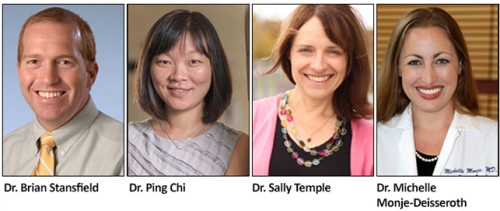


Posted October 9, 2015
Dr. Brian Stansfield, Georgia Regents University
Dr. Ping Chi, Memorial Sloan-Kettering Cancer Center
Dr. Sally Temple, Neural Stem Cell Institute/Regenerative Research Foundation
Dr. Michelle Monje-Deisseroth, Stanford University
 The Neurofibromatosis Research Program (NFRP) utilizes the New Investigator Award (NIA) to introduce the next generation of investigators and their ideas to the neurofibromatosis (NF) research community. Since the first NFRP NIA in 1999, there have been 274 NIA applications received and of those, 58 have been recommended for funding. The goal of this award mechanism is to support the continued development of promising new independent investigators, or established investigators transitioning from other career fields that can bring new techniques or expertise into the field of NF research. Four New Investigator Awards have been awarded most recently for the 2014 program. The research planned by these investigators address different NF questions but all four researchers bring something new to the field of NF.
The Neurofibromatosis Research Program (NFRP) utilizes the New Investigator Award (NIA) to introduce the next generation of investigators and their ideas to the neurofibromatosis (NF) research community. Since the first NFRP NIA in 1999, there have been 274 NIA applications received and of those, 58 have been recommended for funding. The goal of this award mechanism is to support the continued development of promising new independent investigators, or established investigators transitioning from other career fields that can bring new techniques or expertise into the field of NF research. Four New Investigator Awards have been awarded most recently for the 2014 program. The research planned by these investigators address different NF questions but all four researchers bring something new to the field of NF.
Dr. Brian Stansfield of Georgia Regents University is an early career investigator who will use his FY14 NIA to study how inherited mutations in one copy of the NF1 gene in macrophages effects the development of arterial stenosis and formation of aneurysms. Dr. Stansfield hypothesizes that macrophages lacking one functional NF1 allele are directed from the bone marrow to sites of vascular injury (damage to an artery or vein) and produce growth factors and reactive oxygen species that can induce cardiovascular disease. This examination of macrophages may provide understanding as to why some NF1 patients develop cardiovascular disease and others are at risk for aneurysm formation.
Dr. Ping Chi of the Memorial Sloan-Kettering Cancer Center is an established clinician scientist whose laboratory research focuses on several solid tumors including malignant peripheral nerve sheath tumors (MPNSTs). Dr. Chi will use her FY14 NIA to focus on in vivo development of novel therapeutics against NF1-associated MPNSTs, the most common malignancy in NF1 patients. Dr. Chi will investigate whether staining cells for a certain molecule can provide information on disease survival. Dr. Chi will also test whether certain compounds that are already in clinical development are potential candidates for therapy for NF1-associated MPNST by targeting central pathways that are commonly misregulated in all MPNSTs. If successful, these data may accelerate the development of these clinically applicable compounds into early phase clinical trials.
Dr. Sally Temple of the Neural Stem Cell Institute/Regenerative Research Foundation is an established scientist in the stem cell research field. She has been awarded an FY14 NIA to use stem cells to develop an accurate 3D model of the cellular environment surrounding an NF2 tumor. Dr. Temple will test this model to determine whether it can predict NF patient's tumor growth rate and how well individual patients will respond to current and investigational drugs. The successful development of such a model, to be derived using patient's own cells, would have broad applicability for many NF researchers and clinicians.
Dr. Michelle Monje-Deisseroth of Stanford University is an established pediatric neuro-oncologist and neuroscientist whose laboratory focuses on postnatal neurodevelopment. Dr. Monje-Deisseroth will use her FY14 NIA to study the role of neuronal activity in the formation and development of NF1-associated optic pathway gliomas (OPGs). These tumors affect 15-20% of children with NF1 and therapeutic options are limited. Understanding the factors that promote glioma formation, development, and growth is crucial for future development of improved treatment strategies for NF1-associated OPGs, a significant cause of morbidity in individuals with NF1.
Either as an established investigator from another research field or an investigator in the early stages of their careers, the contributions by these researchers is sure to progress NF research to further our understanding of the disease and its many manifestations. CDMRP is pleased to welcome these investigators to the NFRP and look forward to their future contributions.














